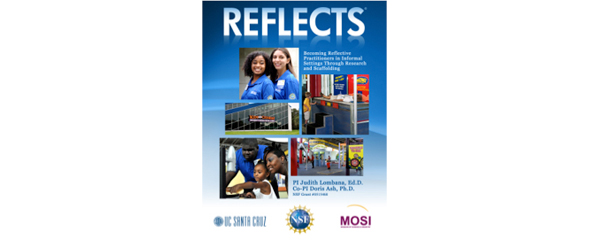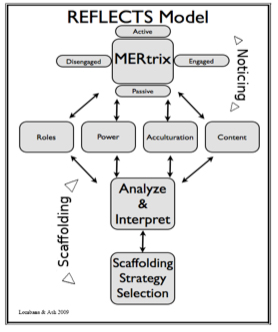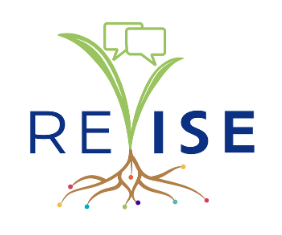
September 26th, 2013
This Spotlight was co-written by Doris Ash and Judith Lombana. One of the biggest challenges informal learning institutions [1] will face over the coming century is offering nuanced professional development designed to help educators work more collaboratively and flexibly with culturally and linguistically diverse learners. We (Judith Lomabana, at the Museum of Science and Industry, Tampa, FL and Doris Ash, at UC Santa Cruz) developed the REFLECTS© Professional Development Guides (NSF DRL-0515468) to help museum educators and their mentors reflectively research their practice in order to more effectively address issues of equity and access. The Museum Educator Researcher and the Mentor Guides are designed to meet the need for practical, yet theory-based museum professional development aimed at working with diverse audiences.
Reflective Practice and Action Research
Our research has suggested that reflective practice, while quite effective in helping practitioners to “see” what they do more clearly, is an insufficient foundation, in and of itself, for transforming practice. Reflective practice typically begins with the educator recognizing that there is some aspect of their teaching that they would like to improve, and involves a continuous cycle of individual and/or groups of educators thinking about and critically analyzing how teaching occurs in museums. Through this, educators become aware of the theory as well as historical, cultural, social or other personal influences that inform their views about teaching and learning, and weigh and evaluate them in order to improve teaching and learning experiences for themselves and learners. There are a variety of tools available to facilitate reflective practice. We have argued that reflective practice combined with ongoing teacher action research has, together, led directly to empowering museum educators to appropriate new identities as flexible mediators (Ash, Lombana & Alcala, 2012) [2]. Like reflective practice, action research typically concerns some aspect of teaching that museum educators would like to improve, and is undertaken by and for the educators themselves. In action research, educators choose a research question, grounded in the day-to-day practice of the educator, such as “what will happen if…?” The process continues by designing a research plan, gathering, monitoring and organizing data, and synthesizing results in order to reflect on and improve the museum educator’s teaching practice. Educators typically feel empowered by this process as they see their results in action.
Working in the Zone of Proximal Development
We have found that museum educators who learn to focus on “working in zone of proximal development,” or “ZPD” [3] have been able to enter into a new relationship with the learners with whom they collaborate. We have discussed how such theory-based practices as reflective practice and action research transformed museum educators’ identities from didactic teachers to scaffolding partners, as well as how they became empowered to conduct their own research (Ash, Lombana & Alcala, 2012). The REFLECTS© model was designed to facilitate such “working in the ZPD,” or scaffolding, between museum educators and diverse families. We consider scaffolding a temporary support that occurs reciprocally, not only unidirectionally. To facilitate museum educator scaffolding, we designed digital video segments, called “scaffolding scenes,” specifically to allow museum educators to practice “seeing” and reflecting on museum learning and teaching episodes. Typically when an educator is working in the ZPD, they first listen and “notice” the nuances, words and ideas of visitors — something that many museum educators do. Uniquely to the ZPD, however, educators first use the initial assessment of visitors’ current understanding to guide them to next steps — to carefully pitch their next actions, with appropriate scaffolding, either toward another level of activity or talk or more questions. By practicing how they might customize scaffolding strategies to meet the needs of diverse visitors, they become familiar with the essential aspects of making visitors comfortable, but also practice how to begin merging their own agendas with those of the family. In the REFLECTS© model, the goal is to help educators create a merged or hybrid learning agenda with families. As educators and mentors watch the digital video “scaffolding scenes,” they experience deep observation of family and educator activity as it occurs on the floor, and they role-play which, if any, scaffolding strategy they might chose. The unique utility of the digital exemplars is that they can be watched many times, by many educators, often with different ensuing dialogue.
The Structure of the REFLECTS© Model
The Basic Museum Educator Researcher and Mentor’s Guides
The REFLECTS© model is based on a cycle of reflective practice, in which museum educators first Notice learner behaviors as they interact at an exhibit. The educator observes the learner’s level of activity and engagement, as well as how comfortable visitors are in the exhibit space, the topic of conversation, how they approach the content, as well as who leads the interaction. Through the Noticing process, the educator then selects a strategy to facilitate scaffolding. Once implemented, the educator evaluates how effective the strategy was, and returns to the beginning of the cycle, again Noticing behaviors and cues. The educators then continue Noticing and scaffolding throughout the interaction. See the REFLECTS© model graphic for an illustration of the process.

The REFLECTS© Model
The REFLECTS© Mentor’s Guide is designed for mentor educators planning to help train other museum educators in using the basic REFLECTS© Guide. It contains a deeper rationale, additional activities, questions, short summaries, and further explanations of content.
The DVD
The DVDs provides specific scaffolding scenes to use with the two guides. The video footage was excerpted from real representative (both productive and unproductive) scaffolding scenes, then remade, using avatars in Second Life®, to protect the anonymity of participating families and museum staff, and to insure clarity of the material. The excerpts are designed to promote dialogue about teaching practices and to highlight the theory and practices noted in the two guides. The DVD is not useful without the guide.
The Guides’ Structure
Both Guides follows the same basic structure:
- Materials: A list of the necessary videos and activities for the chapter.
- Section Summary: A brief summary of the content discussed in the Trainee’s Guide.
- Additional Information: Background information and research pertaining to the given section.
- Discussion Questions: Questions for reflective dialogue.
- Required Video: This subsection lists the videos that are necessary for the given section or activity. A brief summary of the video is provided with the video title.
- Supplementary Video: This subsection lists the videos that are not necessary for a given section or activity, but can be useful. These videos were chosen to demonstrate specific aspects of the given section or topic. A brief summary of the video is provided with the video title.
- Activity Summary: A brief summary about the purpose and intent of the given activities.
- Supplementary Activity: These activities are provided to give additional practice or a deeper understanding of a given topic.
The summative evaluation report of the REFLECTS© model, written by Wendy Dickinson and Bruce Hall, is available from either Lombana (Judith Lombana) or Ash, (Doris Ash). We ask that those using/disseminating the REFLECTS© model please follow these guidelines:
- Cite all written, oral or published work based on these guides to Lombana & Ash, 2011.
- Collaborate with the authors on best use and mentoring.
- Do not copy materials without permission.
Please contact: Doris Ash, University of California, Santa Cruz or Judith Lombana, Museum of Science and Industry, Tampa, FL, for more information.
1. Although we use the term “museum” throughout the article, the Guides are useful in other informal learning institutions, such as zoos, aquaria, gardens, etc. 2. Ash, D., Lombana, J. and Alcala, L. (2012) Changing practices, changing identities as museum educators: From didactic telling to scaffolding in the ZPD; Davidsson, E and Jakobsson, A (Eds.) 23-44, Understanding Interactions at Science Centers and Museums: Approaching Sociocultural Perspectives. Sense Publisher, Rotterdam, Netherlands. 3. Vygotsky’s “zone of proximal development” (ZPD) “defines the distance between learners’ actual and potential developmental levels during problem solving, given the aid of more knowledgeable others.” See Vygotsky, L. S. (1978). Mind in society: The development of higher psychological Processes, Cambridge, MA: Harvard University Press.
